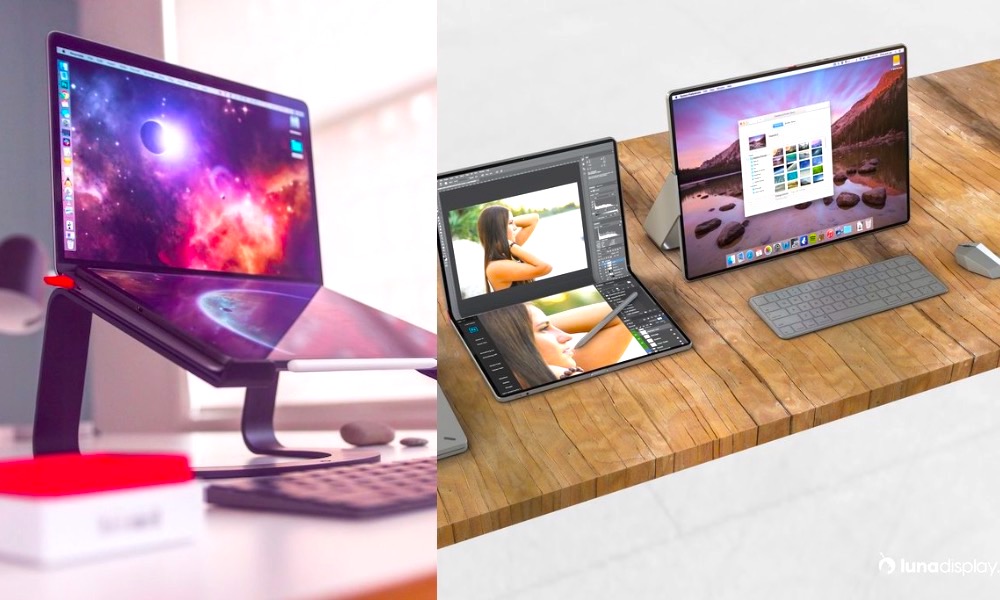Future MacBooks Might Feature Touch-Based Keyboards (That Look and Feel Real)
 Credit: Luna Display
Credit: Luna Display
Toggle Dark Mode
A future MacBook device could ditch a physical keyboard in favor of a touch-based digital one that looks and feels real.
At least, that appears to be something that Apple is working on due to a string of patent applications over the past few years. And today, a new application corroborates Apple’s continued development in the area.
Apple Touch Keyboard Patents
Apple patents are typically written in dense language and today’s patent is even more complex than usual. But, in a nutshell, it appears to describe a screen-based keyboard that simulates motion or feedback based on a method of haptic motors and electrostatic charges.
The end result appears to be a touch-based keyboard similar to the ones you may find on an iPhone or iPad. But before you get too worried, the patent seems focused on ensuring that the digital keyboard looks and feels as close to a physical one as possible. That includes simulated key edges and travel.
The aforementioned electrostatic charge could allow a user’s fingers to “find” the individual digital keys by making it feel like they have a slightly concave shape.
This is far from the first touchscreen keyboard patent that Apple has filed. Several other patents hint at similar technology, which may end up in a future iPad — or even, as we’ve been alluding to, a MacBook Pro.
Benefits of Screen-Based Keyboards
Keyboards are extremely important to computer users. There are plenty of people who are extremely passionate about things like key travel, tactile feedback and even the noise that keys make.
Because of that, the idea of a touchscreen-based keyboard on a computer usually elicits a very negative reaction from users.
But today’s patent seems to be an antidote to that, fixing the problems with touchscreen keyboards while allowing all of the benefits.
As far as those benefits, there are plenty. Just consider the fact that touchscreen keyboards won’t have physical key switches that can break. That’s a far cry from current butterfly keyboards. They may even be more liquid- or water-resistant than physical keyboards.
The actual keyboard surface could also be highly customizable, allowing users to tweak the keyboard based on country, language or preference. In a pinch, users may also be able to swap the keyboard for a flat drawing surface similar to a Wacom tablet.
And, yes, a virtual keyboard could help Apple make its devices thinner. Or, on the flip side, open up more internal space for other hardware components.
How Likely Is This?
Over several years, Apple appears to be slowly moving away from physical buttons on its devices.
Just take the iPhone’s Home button. Back in 2016, Apple replaced the physical Home button with a virtual one that uses haptic feedback to simulate a button press. (Apple, of course, ditched the Home button altogether on the iPhone X in 2017.)
And look at the MacBook Pro. Also in 2016, Apple replaced the top row of function keys with an OLED display called the Touch Bar. Even before that, the company swapped the mechanical trackpad with a Force Touch version.
Even the problem-prone butterfly keyboard seems to be a stepping stone toward a touchscreen future. Its low key travel and slim profile may be one way for Apple to get users used to digital keys.
Of course, rumors of a new scissor-switch design on an upcoming MacBook Pro appear to throw a wrench in these rumors.
But note that well-connected analyst Ming-Chi Kuo suggests that users will be hard-pressed to tell the difference between the new scissor switches and butterfly switches. That suggests that Apple isn’t moving backwards, it’s simply coming up with a solution for its butterfly keyboards.
If you look at the broader industry, there are other signs that physical keyboards may be on their way out. Microsoft’s new dual-screen tablet is one sign, as is the new ASUS ZenBook Pro Duo — which sports what is essentially a supersized Touch Bar.
All of this is to say that the days of physical keyboards may actually be numbered. Not just at Apple, but across the computer industry.






